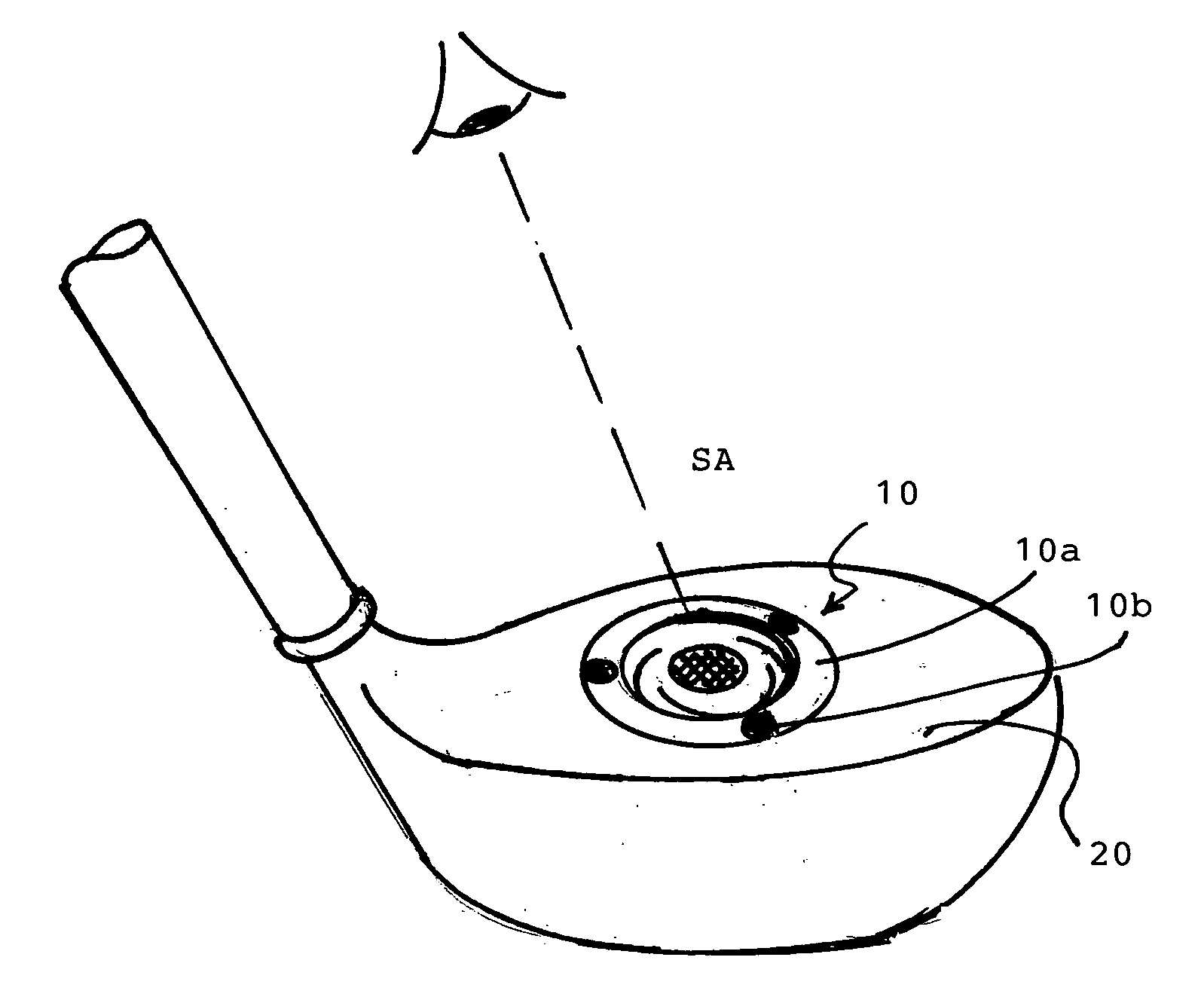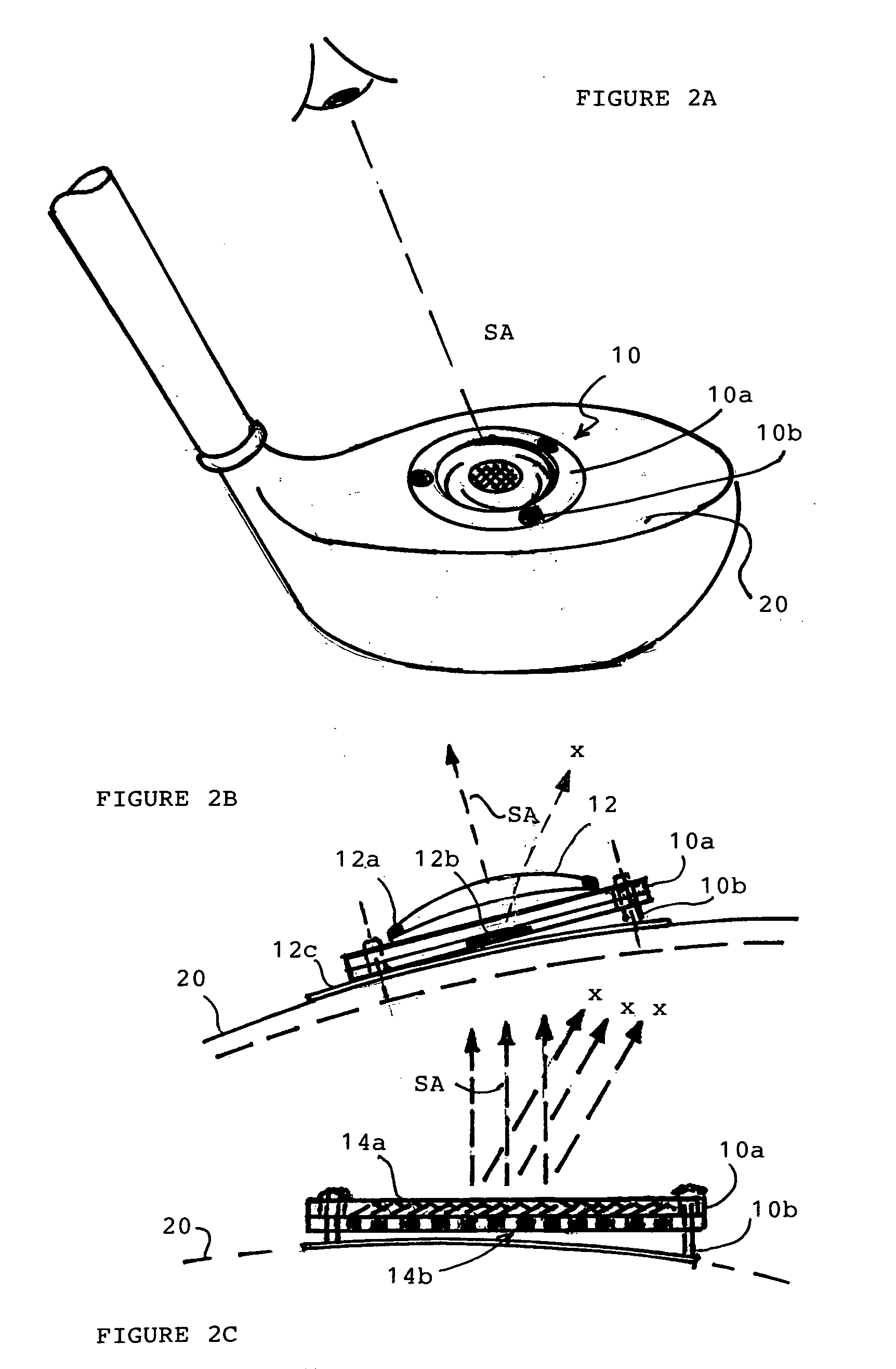Golf club with customizable alignment sighting & weighting device
a golf club and customizable technology, applied in the field of golf club alignment sighting and weighting device, can solve the problems of user inconvenience or burden, and achieve the effects of reducing user inconvenience, reducing intrusion or interference, and facilitating adjustmen
- Summary
- Abstract
- Description
- Claims
- Application Information
AI Technical Summary
Benefits of technology
Problems solved by technology
Method used
Image
Examples
first embodiment
[0028] In FIG. 2A, the golf club alignment sighting device of the present invention is shaped as a planar disc 10 that is mounted on the upper surface 20 of the head of a golf club. The disc has a number (3 or more) of leveling posts 10b spaced around a peripheral rim or ring 10a. By adjusting the leveling posts 10b, the sighting axis SA of the device can be adjusted three dimensionally to a sighting position that is in the preferred alignment position with the eyes of the user. If the user takes up a posture, grip, or stance that results in the user's head (eyes) being out of alignment with the sighting axis SA, the device 10 will not provide the desired target indicator, but would instead provide an indication that the user is not in alignment.
[0029] In FIG. 2B, one version of the planar disc embodiment is shown having a concave lens element 12 mounted on the peripheral ring 10a concentric with the sighting axis SA of the device. The lens element 12 can be adhered by epoxy or othe...
second embodiment
[0034] In FIGS. 4A-4C, the device is shown, designed for a putter. The device is formed in a spherical shape 40 mounted between upper and lower horizontal flanges of the putter head, and clamped in position with an annular collar 43 retained by threaded screw fasteners 41. The spherical device 40 can be made of a medium-hard plastic or dense rubber material, so as to provide a friction holding force when clamped by the collar 43 against the bottom flange of the putter. An annular opening 42 at its top-facing side leads into a hollow tube aligned with the sighting axis SA extending into the spherical body. The bottom plane or shoulder 42a of the tube has a contrasting color or texture imprinted thereon that serves as an inner circle of the target indicator. A color-contrasting edge is imprinted or decal is adhered around the annular opening 42 to serve as an outer circle of the target indicator. The desired target indicator of concentric circles is provided when the user's line of si...
fifth embodiment
[0039] In a fifth embodiment, the alignment sighting device is designed for use in a driver or wood and is combined with a weighting element that allows for adjustment of the club's moment of inertia. In FIG. 8A, an explanation is provided how weight distribution in a driver or wood affects the moment of inertia of the club. In laymen's terms, the moment of inertia (MOI) is a measure of resistance to twisting. MOI is increased by shifting weight distribution as far as possible away from the axis of rotation. The typical driver has a vertical head axis of rotation A, a lengthwise head axis of rotation B, and a sidewards head axis of rotation C, as well as a shaft axis of rotation D. A large head design with high MOI can increase the resistance to twisting around the shaft axis D, which can make it harder to square the club face. To reduce the shaft MOI, it may be desirable to shift some weight to move the center of gravity (checkered ball in the figure) closer to the shaft. In other ...
PUM
 Login to View More
Login to View More Abstract
Description
Claims
Application Information
 Login to View More
Login to View More - R&D
- Intellectual Property
- Life Sciences
- Materials
- Tech Scout
- Unparalleled Data Quality
- Higher Quality Content
- 60% Fewer Hallucinations
Browse by: Latest US Patents, China's latest patents, Technical Efficacy Thesaurus, Application Domain, Technology Topic, Popular Technical Reports.
© 2025 PatSnap. All rights reserved.Legal|Privacy policy|Modern Slavery Act Transparency Statement|Sitemap|About US| Contact US: help@patsnap.com



